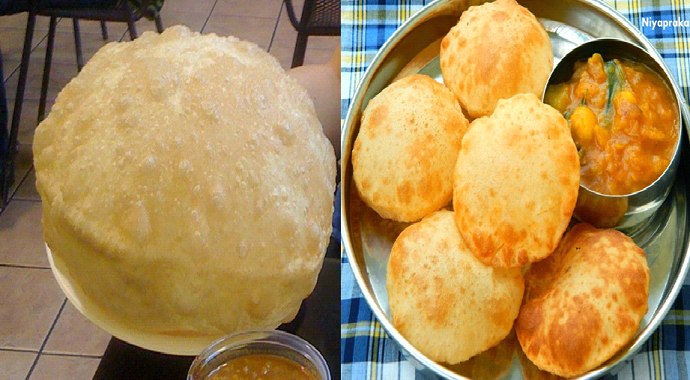
POORI & BATHURA
PURI
Poori or puri, is an unleavened deep-fried Indian bread, commonly consumed on the Indian subcontinent. It is eaten for breakfast or as a snack or light meal. It is usually served with a curry or bhaji, as in Puri bhaji. The name puri derives from the Sanskrit word पूरिका (pūrikā), from पुर (pura) “filled” Puri is prepared with wheat flour, either atta (whole wheat flour), maida (refined wheat flour), or sooji (coarse wheat flour). Maida flour is the most common flour used in making Puris. In some recipes, cumin seed are also added to the dough. A dough of flour and salt is either rolled out in a small circle or rolled out and cut out in small circles and deep fried in ghee or vegetable oil. While deep frying, it puffs up like a round ball because moisture in the dough changes into steam which expands in all directions. When it is golden-brown in color, it is removed and may be served hot with spicy potato curry or mixed vegetable kootu or chickpea curry.
BHATURA
Another popular breakfast or evening dish is Bhatura or chenna bhatura. Bhatura is similar to poori and usually served with chenna masala or chickpea gravy. It is a specialty of State of Punjab, India.
A typical recipe includes white flour (maida), yogurt, ghee or oil, and either yeast or baking powder. Once kneaded well, the dough is left to rise, and then small balls of it are either hand-rolled or flattened using a rolling pin. Then the bread pieces are deep fried until they puff up into a lightly browned, soft, fluffy bread, which is elastic and chewy. The dish is available in almost all eating-places in both south and north India and also on street vendors. The dish can also be prepared at home in a healthier and less-oily manner and also the bhature can be made filled with potato, cottage cheese etc. the dish is considered for a heavy breakfast, Chole Bhature is a great treat for college students who enjoy this delicious dish greatly.
Image Courtesy: https://upload.wikimedia.org/wikipedia/commons/9/97/Bhatura.jpg
Author: Sumana Rao | Posted on: October 9, 2015






















Write a comment